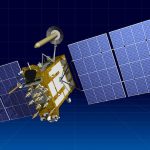No longer consigned to predicting what might one day happen, the folks at the Galileo program can now look at and talk about what is happening right now, starting with initial services. To help us understand what’s going on, we enlisted no less than Matthias Petschke, Galileo Program Director at the European Commission (EC).
No longer consigned to predicting what might one day happen, the folks at the Galileo program can now look at and talk about what is happening right now, starting with initial services. To help us understand what’s going on, we enlisted no less than Matthias Petschke, Galileo Program Director at the European Commission (EC).
“Since the initial service declaration that took place on 15 December 2016,” Petschke told us, “the European Commission and the GSA [European GNSS Agency] have put together an extensive service provision, monitoring and reporting process.”
Beyond the real-time operations of the system, he explained, the performance of Galileo services is being assessed a posteriori on a monthly basis.
“The data collected so far indicate an excellent level of performance,” Petschke said, “well within the performance levels published in the Galileo OS Service Definition Document. In fact, recent independent tests have confirmed that Galileo plus GPS already offers increased accuracy in urban areas over GPS alone.”
It would be hard to overstate the significance of what Petschke is reporting here. A system that for so long was considered by some to be on the verge of becoming the poster child for all that is wrong with the EU – among other things long, convoluted and often contentious decision-making processes – Galileo is finally, and in a very real and measurable way, a success story. The system currently counts 18 satellites in orbit, in various functional states, out of 30 planned.
Except…
We need to point out here that Petschke relayed his remarks to us some days before the first wide scale failure of Galileo services, an event that began on May 14, 2017. When Petschke made his remarks, they were still accurate and pertinent.
More on the service failure later. For now, let’s continue with the good news.
Petschke said the program plans to make public its performance reports on a quarterly basis through the European GNSS Service Center (GSC) website. The first report of this type, covering the first quarter of 2017, is expected in May.
“In parallel,” he said, “the GSA is setting up a fully independent performance monitoring capability, which will be hosted at the Galileo Reference Center (GRC) in the Netherlands. This independent performance monitoring will also include worldwide monitoring capabilities from various EU Member States and should be available as of July 2017.”
Before the failure of May 14, we knew that there had already been some less serious glitches affecting the initial service, but such was to be expected given the level of immaturity of the system, and we were not prepared to dwell on these. One of our sources in Brussels who prefers to remain anonymous did tell us at the time, “The initial services are an important milestone, and are injecting some sense of responsibility into the program.” Yes, the people who for so long were occupied with telling us why it wasn’t ready, are now at last proud owners of a functioning multi-billion-euro space system, and they’re getting a feel for how it handles.
In the Driver’s Seat
Actual hands-on operation of Galileo now falls to the newly designated Galileo Service Operator (GSOp). Working under a 10-year, 1.5-billion-euro contract (about $1.65 billion), Spaceopal is a joint venture between Italy’s Telespazio and the German Space Agency (DLR). After a long and complex tendering process that started in January 2015, Spaceopal and the GSA officially signed the GSOp contract last December, on the very day when initial services were launched.
Under GSA management, Spaceopal is charged with securing Galileo operations from two mission control centers (GCCs), one located in Germany and the other in Italy, and it is to provide user sup-port services through the European GNSS Service Centre (GSC) in Spain.
Spaceopal will manage the Galileo Data Distribution Network (GDDN) and provide integrated logistics support and maintenance for the entire space and ground infrastructure. Finally, the group will monitor system performance and otherwise support to the best of its ability the ongoing roll-out of Galileo infrastructure and associated launches.
Petschke told Inside GNSS, “The handover of operations from the current contractual set-up to the Galileo Service Operator is being conducted according to plan, following a series of milestones to verify readiness in a number of areas. The GSA has already put in place its own internal organization to fully oversee service delivery as of July 2017.”
To that end, the GSOp contract includes a set of clear and tangible key performance indicators (KPIs), against which the GSA will assess the work of the Spaceopal.
In reality, there has been little anxiety to be felt over Spaceopal’s ability to do the job, the group having already served as the contractor for Galileo operations since 2010 under the Galileo Full Operational Capability (FOC) Operations Framework Contract. At the new GSOp contract signing ceremony in Prague, Spaceopal CEO Giuseppe Lenzo gave every impression of being up to the task, assuring the gathered happy dignitaries that his group is committed to continuing to support the deployment and completion of the Galileo system.
PRS Included
Of the various services promised over the years by the Galileo program, the Public Regulated Service (PRS) always seemed the least likely to get off the ground without a hitch, among the doubters, that is.
And yet, speaking at the Munich Satellite Navigation Summit earlier this year, Christoph Kautz, European Commission Galileo and EGNOS Deputy Head of Unit, was able to remind participants that the PRS was indeed among the Galileo initial services declared last December.
The PRS comprises a dedicated, authenticated and encrypted service for governmental authorized users in areas such as public safety and security, critical infrastructure, and defense.
Speaking at the same event in Munich, GSA PRS Manager Charles Villie described the PRS as an encrypted navigation service designed to be more resistant to jamming, involuntary interference and spoofing, “…offering continuity of service, including higher availability of the signal in space and providing an independent authenticated position, velocity and timing service.”
The main task now is to make the transition to exploitation, Kautz said. And the EC, he added, is looking forward to full deployment of the Galileo constellation by 2020, working in concert with the relevant ground system elements, including the Galileo Security Monitoring Center (GSMC) near Paris and the Competent PRS authorities (CPAs) that need to be established in Member States in order to access and control the use of the PRS within their borders.
Kautz made no mention of the putative back-up GSMC supposed to have been located in the UK, the country whose status within the program has been thrown up in the air in the wake of its decision to leave the European Union. But then no one within the Galileo program, not even Kautz, is volunteering any substantive thinking of any kind on that most embarrassing of issues. The one and only official response to all questions Brexit is “we don’t know yet”.
Kautz went on to argue that, following the publication of the EU’s Space Strategy in 2016, it is likely that the range of security-related space applications will increase in the future, and there could therefore [hopefully] be an increased demand for the more secure and robust PRS service.
Meanwhile, a majority of the EU European Member States have now established their CPAs, and a number of non-EU countries have expressed interest in using the service. Negotiations on that last score are being held tightly under wraps.
Villie insisted: “Today all PRS functionalities are available. The whole infrastructure is functional and operational and authorized users can test their procedures for real and can check PRS functionalities themselves.”
PRS receiver concepts have already been developed and validated under a battery of pilot projects funded by the EU’s Horizon 2020 program.
As for user acceptance, Villie said, that is going to depend plainly and simply on whether or not the PRS can prove its worth. A range of testing and demonstration activities is being carried out through 2017.
So, these are still very early days for the PRS, but some users appear to be sold already. Speaking on behalf of the German CPA, Lukas Schmid of the German Transport Ministry said he saw many potential applications for the PRS within the police and security services. As an example, he said, server-based Galileo PRS solutions for authenticated positioning and timing that are available today could significantly simplify the tracking of tagged terrorist suspects.
He also described the “Hali Berlin” project under which traffic lights were synchronized for emergency vehicles, with the PRS helping to secure the application. The procedure greatly reduced the time it took for emergency vehicles to get to incidents while also reducing the number of accidents involving those vehicles. Schmid said further joint test activities between Germany, Belgium and other Member States are slated. Also, proclaiming the potential benefits of the PRS was Colonel Philippe Bertrand, head of the French CPA, which is now also part of an organization that will ensure the interoperability of Galileo PRS with military GPS for the French Ministry of Defense.
During 2016, the French CPA along with the French MoD and the French Space Agency (CNES) undertook in-depth PRS validation activities, including monitoring and security tests. Bertrand told participants at the Munich event, “It is very clear that the PRS’ navigation performance is really very good and very interesting.”
Much like Villie though, Bertrand said he thought that large numbers of users will only come if the PRS lives up to its pledges, e.g., gaining full operational capability by 2020 and providing the promised very high level of security.
For his part, Petschke is confident the PRS will come through: “The PRS is already in its initial service phase and the Galileo program is committed to achieving the objective of full operational capability by the end of 2020.”
On the Other Hand
Petschke said that while the PRS is definitely alive and kicking, the equally-anticipated Galileo Commercial Service (CS) is still a ways off: “The first signal transmissions for the Commercial Service should take place late in 2018.”
The CS has seen its ups and downs and it was glaringly though not unexpectedly absent from the package of initial services launched in December. The service has been described as encrypted and accurate to the nearest centimeter, allowing for the development of applications for professional or commercial use owing to improved performance and data with greater added value than that obtained through the open service.
We have it on good authority that an invitation to tender for the pre-selection phase of the CS service provider is likely to be issued by the end of this year. So, the CS is still a going concern, but users will have to wait a while longer to get a feel for what it can do.
Still No Getting Away From….
Clearly a major source of disappointment, both inside and outside the program, continues to be the affair of the failed Galileo satellite onboard clocks. But not to harp on the issue, as we do believe there is reasonable potential benefit to be gained by bringing to light certain observations.
Readers will remember the failure of a number of Galileo onboard clocks, as revealed by European Space Agency Director General Johan-Dietrich Woerner last January. At that time, he said, nine of the 72 orbiting clocks had failed – three rubidium clocks and six passive hydrogen maser [PHM] clocks. One additional PHM clock had failed, but had been successfully restarted.
And, Woerner told reporters, the decision to use the Italian-produced clocks was part of a larger European “political” strategy. “This discussion of Galileo as a whole was a strategic decision,” he said. “We wanted to have an autonomous European solution for satellite navigation and so to have these systems based on European technology was a clear political decision.”
He and others have made clear since then that the clock failures, while indeed troubling, have had no effect on the operational integrity of the Galileo system.
Most recently, Petschke told us, “The ESA-led investigation has significantly progressed and should be able to confirm a resolution plan that contains the risks in the weeks to come.”
The fact that a resolution plan is still in progress, four months after the problem was revealed, is neither disquieting nor reassuring. If the plan does not surface within the cited weeks, that will be disquieting.
“This plan would include both a refurbishment program for the next satellites to be launched and operational procedures for the satellites in orbit. The next launch is planned to take place in December this year,” Petschke said.
One anonymous source in Brussels told us, “The clock problem is being resolved. The rubidium clocks will all need retrofitting, but this will have little or no impact on the launch schedule.
Galileo Goes Off
Having been fair in giving the Galileo program the credit it is due, and we do believe it is due much credit, we feel equally minded to record its failures. The following Notice Advisory for Galileo Users (NAGU) was issued on 15 May 2017, announcing such a failure beginning on 14 May.
“EVENT DESCRIPTION: NAVIGATION MESSAGES NOT REFRESHED FOR ALL SATELLITES SINCE 2017-05-14 15:50 UTC UNTIL FURTHER NOTICE.”
During the event, one individual who is close to the program spoke of disappointment over a complete failure after just five months of initial services.
Another inside source told us the failure involved one part of the Galileo ground segment, nothing to do with the onboard clocks.
While the failure notice was still in effect, an ESA spokesperson confirmed to us, “A hardware equipment malfunction in the ground segment affected the functioning of the Galileo system. As a result the navigation message for all satellites has not been refreshed since 15:50 on 14/05/2017. The cause of the malfunction has been identified, the equipment concerned has been replaced and the recovery of the services to their nominal levels has started.”
On May 17, three days after the beginning of the event, the follow-up NAGU appeared:
“EVENT DESCRIPTION: CONDITIONS LEADING TO NAVIGATION MESSAGES NOT TIMELY REFRESHED FOR ALL SATELLITES HAVE CONCLUDED.”
During the length of the event, there was no tentative recovery date given. Some very hard questions are now being asked, both within and without the Galileo program. Here are just a few such questions that have been suggested to us:
1) Is the Galileo technical infrastructure mature enough to provide committed services?
2) Have the European Commission, the GSA and the ESA invested enough in the organizational aspects of Galileo, including logistics, and considered with due attention the meaning and implied responsibilities of service provision?
3) Is it clear to all of them what the difference is between developing a technology, procuring and integrating a system, operating a system and providing services continuously and reliably?
We will be watching and asking these questions of the responsible agencies as the Galileo program moves forward.
Also, we are asked to imagine where we would be if GPS were to suddenly announce a complete service failure, with no recovery date given. Various unpleasant epithets immediately come to mind. As far as we know, this has never happened to GPS, however some problems have occurred in GPS operations over the years, including the Jan. 26, 2016, software upload that adversely affected the GPS system time/UTC offset information in the navigation message and caused a lot of problems for users. See the article here.
We have also been reminded of certain outspoken claims regarding Galileo’s eventual superiority to GPS (and we know there are voices expressing at every opportunity a deep and abiding respect for the immeasurable hard work and dedication that has made GPS, GLONASS and BeiDou what they are today).
All are eager to see an improved and strengthened Galileo, but there is also a perceived need to shake up the establishment, to encourage heightened diligence and, in some cases, a little humility.
In the end, this latest event could serve the maturing Galileo program well. But that will depend on how the relevant parties respond, starting now.





